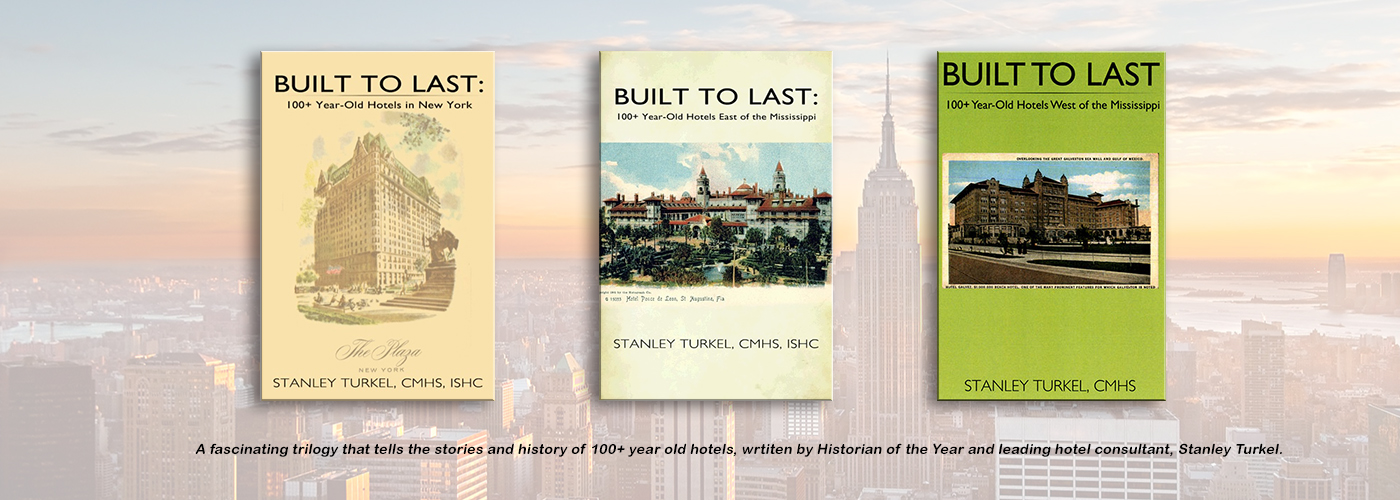Nobody Asked Me, But… No. 252: Hotel History: Libby’s Hotel and Baths
Stanley Turkel | August 03, 2021
Hotel History: Libby’s Hotel and Baths, New York, N.Y.
In the late 1920s, the stock market was soaring, businesses were enjoying record profits and developers were constructing new buildings at a rapid pace. Mortgage companies began offering mortgage-backed securities, a new type of investment.
One of the new buildings was the 12-story Libby’s Hotel and Baths, built in 1926 at the corner of Chrystie and Delancey Streets in New York’s lower east side. It was the first all-Jewish luxury hotel with an ornate swimming pool, modern gym, Russian-Turkish baths and lounges open to the entire community.
The developer was Max Bernstein, an immigrant from Slutzk, Russia, who arrived in New York with his family in 1900 when Max was 11 years old. The streets where Max grew up on the lower east side were filled with pushcart vendors, some with horse-drawn wagons, kids playing street games and tenement dwellers socializing on the stoops. Unfortunately, when his mother Libby died within one year, Max ran away from home and spent the night in a small park nearby. In later years, Max said that his dream of building Libby’s Hotel on the corner of Chrystie and Delancey Streets came to him that night.
After years of owning a series of restaurants, each of them named Libby’s, Max was able to acquire land on his favorite corner where he built the hotel that opened on April 5, 1926. Max was apparently a natural-born publicist because he invested an extraordinary amount of energy and money in an extensive promotional campaign in the many Yiddish-language daily newspapers. On opening day, the New York Times joined the other papers in reporting the grand opening. The Libby Hotel featured a spectacular two-story lobby with a richly colored plaster ceiling supported by fluted marble columns. The hotel had meeting rooms, ballrooms and two kosher restaurants. Max held charity events and swimming classes for neighborhood children.
The Libby Hotel broadcast from the first Yiddish radio station, WFBH (from the top of the westside Hotel Majestic) featuring famous entertainers, live theater and such luminaries as Sol Hurok, Rube Goldberg and George Jessel. Bernstein spared no expense, hiring as his musical director Josef Cherniavsky, leader of the Yiddish-American Jazz Band and widely known as the Jewish Paul Whiteman. For its first two years, the hotel seemed to be a huge success but by the end of 1928, the roof fell in.
A glut of new hotels had opened in New York. Many, in order to remain solvent, began to cater to Jews, siphoning off Max’s clientele. Max might have been better able to compete if his emotional state was not already in a downward spiral; on October 20, 1926, his wife Sarah died. In a later court trial, Max would testify that the grief he experienced left him unable to function.
Furthermore, his primary creditor was the American Bond and Mortgage Company (AMBAM), an unreputable predatory lender. Just prior to the 1929 stock market crash, AMBAM foreclosed on the hotel and, in a strange twist of fate, Mayor Jimmy Walker appointed Joseph Force Crater, a Tammany-connected lawyer as the receiver. According to Judge Crater, AMBAM may have had inside knowledge of the city’s plan to widen Chrystie Street. In any event, AMBAM now claimed that the hotel was worth $3.2 million (after valuing Libby’s Hotel at only $1.3 million for foreclosure). Through eminent domain, New York City took ownership and paid AMBAM $2.85 million. The city then demolished the buildings in the block including Max Bernstein’s Libby’s Hotel and Baths.
But, there’s more to the story. In 1931, AMBAM was convicted of a similar scheme regarding the Mayflower Hotel in Washington, D.C. The same Judge Crater was the receiver for the Mayflower foreclosure. He disappeared four months later and has not been found since. Chrystie Street was widened, the Great Depression set in and ultimately, the site was turned into the Sara Delano Roosevelt Park by Robert Moses.
When Max Bernstein died on December 13, 1946, the New York Times obituary wrote: “Max Bernstein, 57, Once Hotel Owner… Built $3,000,000 Edifice in Slums, only to see Memorial to Mother Razed.”
That would be the end of this fascinating story except that the Pakn Treger* article reported the following sequel:
The story of Libby’s faded into obscurity until the summer of 2001, when a section of the pavement near the corner of Chrystie and Delancey Streets caved in, creating a sinkhole. The hole grew large enough to swallow an entire tree and began to encroach on city streets and the nearby senior center in Sara Delano Roosevelt Park. In those innocent days before September 11, the sinkhole seemed to be the biggest threat facing lower Manhattan.
City engineers did not know the cause, so they lowered a camera into the void. To their astonishment, 22 feet below the surface they found an intact room, complete with bookcases. When they searched records at the Municipal Archives, they learned that Libby’s Hotel once stood there and that they had discovered a room in its subbasement. In a New York Times article from September 11, 2001, New York City Parks Commissioner Henry J. Stern was quoted as saying, “It reminds me of Pompeii.”
In contrast to Pompeii, no attempt was made to reach the room or excavate it. The city engineers chose to fill it with grout, burying the room and its mysterious contents. A new tree was planted, and the park repaved.
* “Ritz with a Shvitz” by Shulamith Berger and Jai Zion, Pakn Treger, Spring 2009
My Newest Book “Great American Hotel Architects Volume 2” was published in 2020.
All of my following books can be ordered from AuthorHouse by visiting www.stanleyturkel.com and clicking on the book’s title.
- Great American Hoteliers: Pioneers of the Hotel Industry (2009)
- Built To Last: 100+ Year-Old Hotels in New York (2011)
- Built To Last: 100+ Year-Old Hotels East of the Mississippi (2013)
- Hotel Mavens: Lucius M. Boomer, George C. Boldt, Oscar of the Waldorf (2014)
- Great American Hoteliers Volume 2: Pioneers of the Hotel Industry (2016)
- Built To Last: 100+ Year-Old Hotels West of the Mississippi (2017)
- Hotel Mavens Volume 2: Henry Morrison Flagler, Henry Bradley Plant, Carl Graham Fisher (2018)
- Great American Hotel Architects Volume I (2019)
- Hotel Mavens: Volume 3: Bob and Larry Tisch, Ralph Hitz, Cesar Ritz, Curt Strand (2020)
If You Need an Expert Witness:
For the past twenty-seven years, I have served as an expert witness in more than 42 hotel-related cases. My extensive hotel operating experience is beneficial in cases involving:
- slip and fall accidents
- wrongful deaths
- fire and carbon monoxide injuries
- hotel security issues
- dram shop requirements
- hurricane damage and/or business interruption cases
Feel free to call me at no charge on 917-628-8549 to discuss any hotel-related expert witness assignment.
ABOUT STANLEY TURKEL

Stanley Turkel was designated as the 2020 Historian of the Year by Historic Hotels of America, the official program of the National Trust for Historic Preservation. He had previously been so designated in 2015 and 2014.
This award is presented to an individual for making a unique contribution in the research and presentation of historic hotels and whose work has encouraged a wide discussion of greater understanding and enthusiasm for American History.
Turkel is the most widely published hotel consultant in the United States. He operates his hotel consulting practice serving as an expert witness in hotel-related cases, provides asset management and hotel franchising consultation. He is certified as a Master Hotel Supplier Emeritus by the Educational Institute of the American Hotel and Lodging Association.
Categories
- Industry Happenings (25,812)
- Latest news (7,344)
- Technology (5,129)
- Operations (3,850)
- All Things Independent (3,730)
- Market Reports (1,873)
- Development (1,643)
- Finance (1,223)
- Appointments/People on the Move (1,208)
- Smart Strategies (1,189)
Instagram post 18072439732009889
Instagram post 18037678936156831
Instagram post 17870090452391124
Instagram post 17976176743256949
Instagram post 17993811919233333
Tags
hotel historyLibby’s Hotel and Bathsnobody asked mestan turkelstanley turkel
RELATED NEWS:
Nobody Asked Me, But… No. 250: Hotel History: Mohonk Mountain House, New Paltz, New York
Nobody Asked Me, But… No. 249: Hotel History: Ocean House at Watch Hill
Nobody Asked Me, But… No. 248: Hotel Theresa, New York, N.Y. (1913)
Nobody Asked Me, But… No. 247: Hotel History: Driskill Hotel, Austin, Texas
Nobody Asked Me, But… No. 246: Hotel History: Hotel McAlpin, New York, N.Y. (1912)
Nobody Asked Me, But… No. 245: Boone Tavern Hotel, Berea, Kentucky (1855)
Nobody Asked Me, But… No. 244: Hotel History: Wormley Hotel
Nobody Asked Me, But… No. 243: Hotel History: Hotel Roanoke, Virginia
Nobody Asked Me, But… No. 242: Hotel History: Fisher Island, Miami, Florida
Nobody Asked Me, But… No. 241: Hotel History: Menger Hotel
Nobody Asked Me, But… No. 240 Fairmont Le Chateau Frontenac, Quebec City, Canada (1893)
Nobody Asked Me, But… No. 239: Hotel History: The Algonquin Hotel, NY (1902)
Nobody Asked Me, But… No. 238: Hotel History: The Fairmont Hotel in San Francisco
Nobody Asked Me, But… No. 237: Hotel History: Hotel Allegro, Chicago, Illinois
Nobody Asked Me, But… No. 236: Hotel History: The Hermitage Hotel
Nobody Asked Me, But… No. 235: Hotel History: Cavallo Point, The Lodge at the Golden Gate (1901)
Nobody Asked Me, But… No. 234: Curt R. Strand, President, Hilton International
Nobody Asked Me, But… No. 233: Hotel History: The Adolphus Hotel
